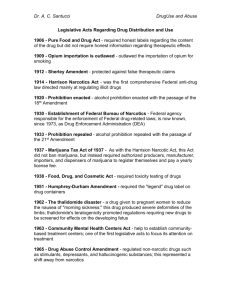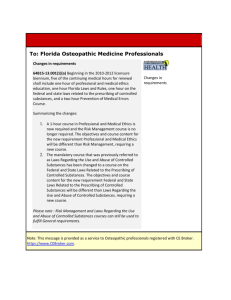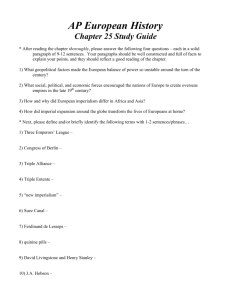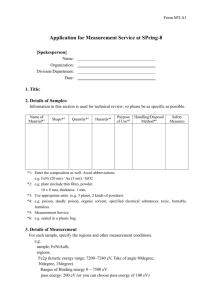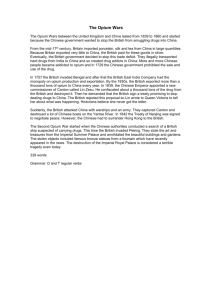Drug_Report - Jessica R. Campbell
advertisement
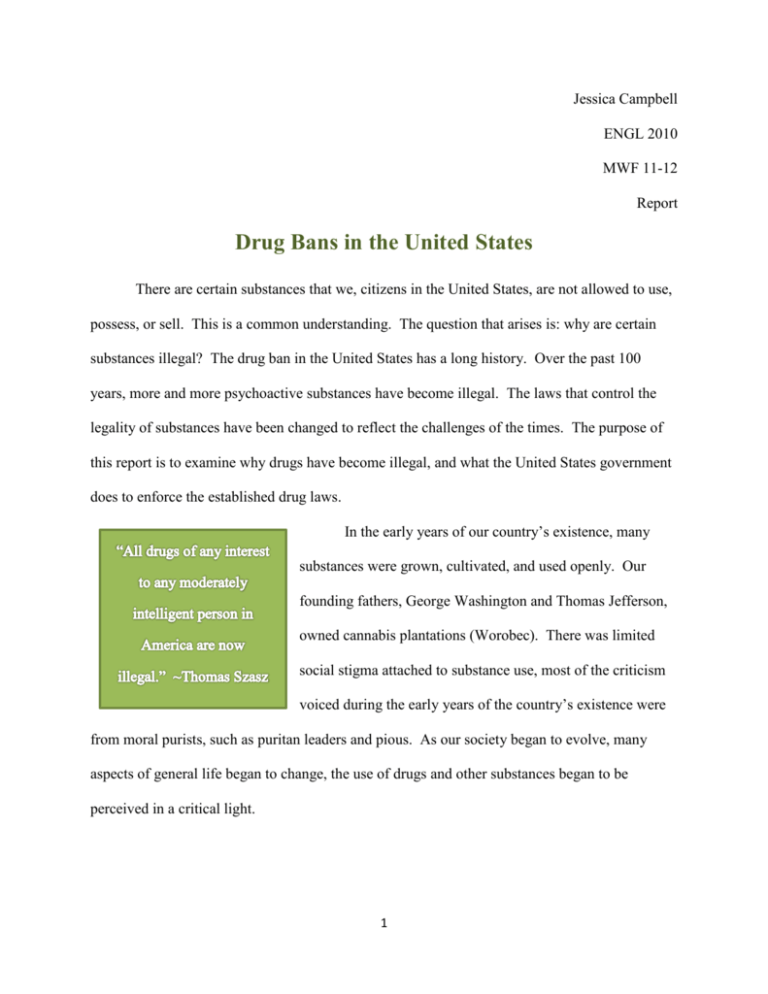
Jessica Campbell ENGL 2010 MWF 11-12 Report Drug Bans in the United States There are certain substances that we, citizens in the United States, are not allowed to use, possess, or sell. This is a common understanding. The question that arises is: why are certain substances illegal? The drug ban in the United States has a long history. Over the past 100 years, more and more psychoactive substances have become illegal. The laws that control the legality of substances have been changed to reflect the challenges of the times. The purpose of this report is to examine why drugs have become illegal, and what the United States government does to enforce the established drug laws. In the early years of our country’s existence, many substances were grown, cultivated, and used openly. Our founding fathers, George Washington and Thomas Jefferson, owned cannabis plantations (Worobec). There was limited social stigma attached to substance use, most of the criticism voiced during the early years of the country’s existence were from moral purists, such as puritan leaders and pious. As our society began to evolve, many aspects of general life began to change, the use of drugs and other substances began to be perceived in a critical light. 1 Opium Use and the Birth of Awareness In the 19th century opium was a widely used drug. It had spawned the development of many medicinal drugs, such as codeine and morphine, and many people enjoyed using it as a way to relax. The development and use of morphine in the medical field transformed procedures from a cruel reality of life to genuinely necessary practice. As the compounds of opium were isolated and refined, even more potent substances introduced themselves into our society. The most significant of these was heroin. As opiates gained adherence and were marketed as a variety of A classic image depicting an opium user in the early 20th century. (OpiumSmokingWest5) cure-alls, the concern of dependence and abuse grew. In the late 1800’s Chinese immigrants began to populate the western seaboard, and they brought the recreation of opium smoking with them. As the United States government grew weary of the abundant droves of Chinese immigrants, they began to pass restrictions on immigration, export/imports, and small businesses that were established by this minority group. Thus, in 1875, the first laws were created in “Thou hast the keys of Paradise, oh, just, subtle, and mighty opium!” ~Thomas De Quincey, Confessions of an English Opium-Eater, Part II 2 California to ban opium use in opium dens, thereby addressing the growing concern of opium dependence and stifling the entrepreneurial efforts of the newly migrated Chinese people (druglibrary.org). This spawned the beginning of public awareness to substance abuse. Drug Legislation Year 1906 1909 1915 1917 1920 1937 1965 1970 1973 1984 1986 1986 Legislation Pure Food and Drug Act Smoking Opium Exclusion Act Harrison Narcotic Act The First War On Drugs Prohibition Marihuana Tax Act Drug Abuse Control Amendments Comprehensive Drug Abuse Prevention & Control Act Drug Enforcement Administration was created Comprehensive Crime Control Act Anti-Drug Abuse Act Controlled Substances Analogue Enforcement Act (Gahlinger 54) With growing support and pressure from the public, government officials began to feel increasing pressures to create laws that would help govern the potential drug epidemic. This was also exacerbated by economic pressures and concern over public moral standards. The first federal law to pass was the Pure Food and Drug Act in 1906. There was growing concern over the additives that were in medications and foods. Before the Pure Food and Drug Act passed, there was no way to know exactly what were in the products people were consuming, except for what the manufacturer voluntarily disclosed. As knowledge of additives to consumer products, the public became increasingly weary of the rampant use of psychoactive drugs in everyday life. Moral crusaders began to campaign about the evils substances can cause. Slogans, ad campaigns, and public rhetoric were becoming common place in the early 20th century. As public opinion began to conform to these campaign 3 tactics, there was an outcry to put an end to the abominable use of opium. In 1909 the Smoking Opium Exclusion Act was passed, and opium was officially banned by the federal government (Gahlinger 34). Congressman Francis Barton Harrison, an outspoken objector to the use of narcotics, trail blazed the legislation involved in passing the Harrison Narcotic Act of 1915. This act was originally passed as a method of tracking prescriptions in an effort to prevent addiction to specific narcotics, but quickly became a tool for banning the illicit substances (Gahlinger, 35). When the law passed, opioids and cocaine were among the drugs to be heavily regulated, cannabis, however, was removed from the bill to ensure that the law would pass with limited political resistance. Five years later, a change in the social fabric occurred 1920: Prohibition. Prohibition made it illegal to manufacture, distribute, a consume alcohol. Prohibition aided in changing the way people viewed the controls over mind altering substances, the spirit of temperance was the fueling force behind the law change. However, the majority of the public resisted the restrictions placed on alcohol, and, as a result, the demand for alcohol was fierce. Prohibition laid the foundation for organized drug rings. The mafia jumped at the chance to be able to make a profit on providing the public with the substance. Though the mafia gained its momentum during this time, they were not the only ones producing and distributing alcohol. The underground of “moonshiners” and “rumrunners” were the majority responsible for the abundant supply to the public. Many small time family sills popped up through the American “I've never had a problem with drugs. I've had problems with the police.” ~Keith Richards 4 front, numerous people certified themselves as religious leaders so they could pass “sacramental wine”, and even physicians would prescribe alcohol to their patients (Fish 51). Alas, Prohibition was short lived, and in 1933 the Prohibition laws were appealed (drug-rehabs.org). The Great Depression brought out the nasty side of the United States Populous. Many people detested the immigration of Mexicans and blamed them for the unwelcomed labor pool. Because Mexican’s were associated with marijuana, a new tax called the Marihuana Tax Act was passed as a strategy to pull revenues from this minority pool of workers. Commissioner Harry Anslinger sensationalized the dangers of reefer madness purporting that marijuana was the Devil’s weed. With the help of William Randolph Hearst, a major paper supplier in direct competition with the hemp 1940’s anti-marijuana advertisement (Devils_Harvest2) industry, wide spread publications of the negative allegations that cannabis was a dangerous drug took hold of the American public (Gahlinger 57). In the 1960s, people took th The mid-20 century brought about a lot of acid to make the world legislative changes. The post-war era was littered with amphetamine and hallucinogen abuse. These two types of drugs were held responsible for the chaos and distress of weird. Now the world is weird, and people take Prozac to make it normal.” ~Author Unknown the 1960’s. With the hippie movement in full swing, the image of irresponsibility and mayhem encompassed the imaginations of the average American 5 citizen. In 1965 the government was overwhelmingly supported in legislation that would help prevent and control the abuse of drugs and other substances (Drug Abuse Control Amendments). 1970 ushered in the Comprehensive Drug Abuse Prevention and Control Act. These laws connected all of the previous drug laws together in a network that would allow enforcement practices to utilize this one act versus dozens of separate laws. Finally, in 1973, the federal government created the Drug Enforcement Agency (DEA). The DEA transformed the way the laws, enforcement, and monitoring of drugs was organized (justice.gov). Conclusion Through the last 100 years, many factors have contributed to the drug bans that our society lives with on a daily basis. Some of the laws that had been passed were quickly overturned, such as Prohibition. However, other laws have held strong, largely because of the support from American citizens, such as the Harrison Narcotic Act. With every new law that is passed that restricts the use of illicit substances, the government must create some method to enforce the new laws. This has created a storm of controversy, as people have begun to wonder where human rights end and protection begins. Most significantly, everyone must understand where our current laws stem from, and why they were initially passed. “Did you know America ranks the lowest in education but the highest in drug use? It's nice to be number one, but we can fix that. All we need to do is start the war on education. If it's anywhere near as successful as our war on drugs, in no time we'll all be hooked on phonics.” ~Leighann Lord 6 Works Cited “Devils_Harvest2.” 1942. Photograph. Portland NORML. Web. 27 Jan. 2011. Fish, Jefferson M. Drugs and Society: U.S. Public Policy. Lanham, MD: Rowman & Littlefield, 2006. 51. Gahlinger, Paul M. "Chapter 3: The War on Drugs." Illegal Drugs: a Complete Guide to Their History, Chemistry, Use and Abuse. New York: Plume, 2004. 56-86. "History Of Drugs - History Of Drug Abuse - History Of Drug Addiction." Drug Rehab Alcohol Drug Rehabilitation Addiction Treatment Programs. 2002. Web. <http://www.drugrehabs.org/history-of-drugs-c.htm>. Opinions, Adam Worobec Gauntlet. "The Gauntlet® Opinions - The Case for Hemp: Good to Wear, Bad to Smoke." The Gauntlet® - The University of Calgary's Student Newspaper. 27 Jan. 2011. Web. <http://thegauntlet.ca/story/15206>. “OpiumSmokingWest5.” 1920. Photograph. Opium Museum. Web. 27 Jan. 2011. United States of America. Drug Enforcement Administration. Welcome to the United States Department of Justice. Web. 06 Feb. 2011. <http://www.justice.gov/dea/history.htm>. "When and Why Were the Opiates and Cocaine Outlawed?" DRCNet Online Library of Drug Policy. Web. 06 Feb. 2011. <http://www.druglibrary.org/Schaffer/library/opiates_outlawed.htm>. 7 Jessica Campbell ENGL 2010 -- MWF 11-12 Reflection The papers were very comfortable for me to write. This is my 5th semester in college, and I have had a good deal of experience with writing. The most interesting aspect of writing a report in an English class is the attention to style. I have never before written a report that required visual images. Typically, these types of papers have been standard one inch margins, New Times Roman font, and 12 pt. So, it was interesting to adapt the writing requirements to my practiced writing style. The other interesting aspect of writing these papers was MLA formatting. I have always practiced APA formatting, as I am in the psychology field and that is the standard writing style. In determining the visual highlights of my report I first had to make a plan. I didn’t want my paper to be too busy, but I understood the need for visual interest. So, I started with an outline of major points that I wanted to write about. Then, I highlighted those points and set out to create relevant headers, quotes, graphs, and images. It was incredibly important that I chose visuals that were directly relevant to the information I was relaying in my paper. By taking a logical and practical approach to creating the style of the paper, I was relieved at how smoothly the report came together. Because I wasn’t very familiar with MLA formatting, I decided that I needed to do some research and learn the theory of the MLA style. I found two older writing books that I own, my current text book, and visited several university English webpages in order to learn how to create a paper in MLA format. The most significant difference between MLA and APA is the citation rules. I found that I had to have the citation rules on hand so that I entered that information in the in text citing and the works cited areas properly. 8
